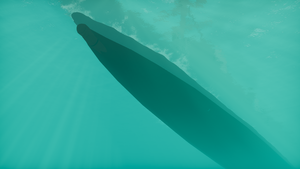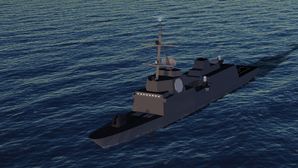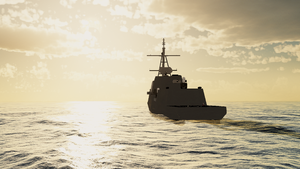Orion-Class Frigate
|
Orion Class
Orion Class Guided-Missile Frigate
|
|||||
|---|---|---|---|---|---|
| Ship | |||||
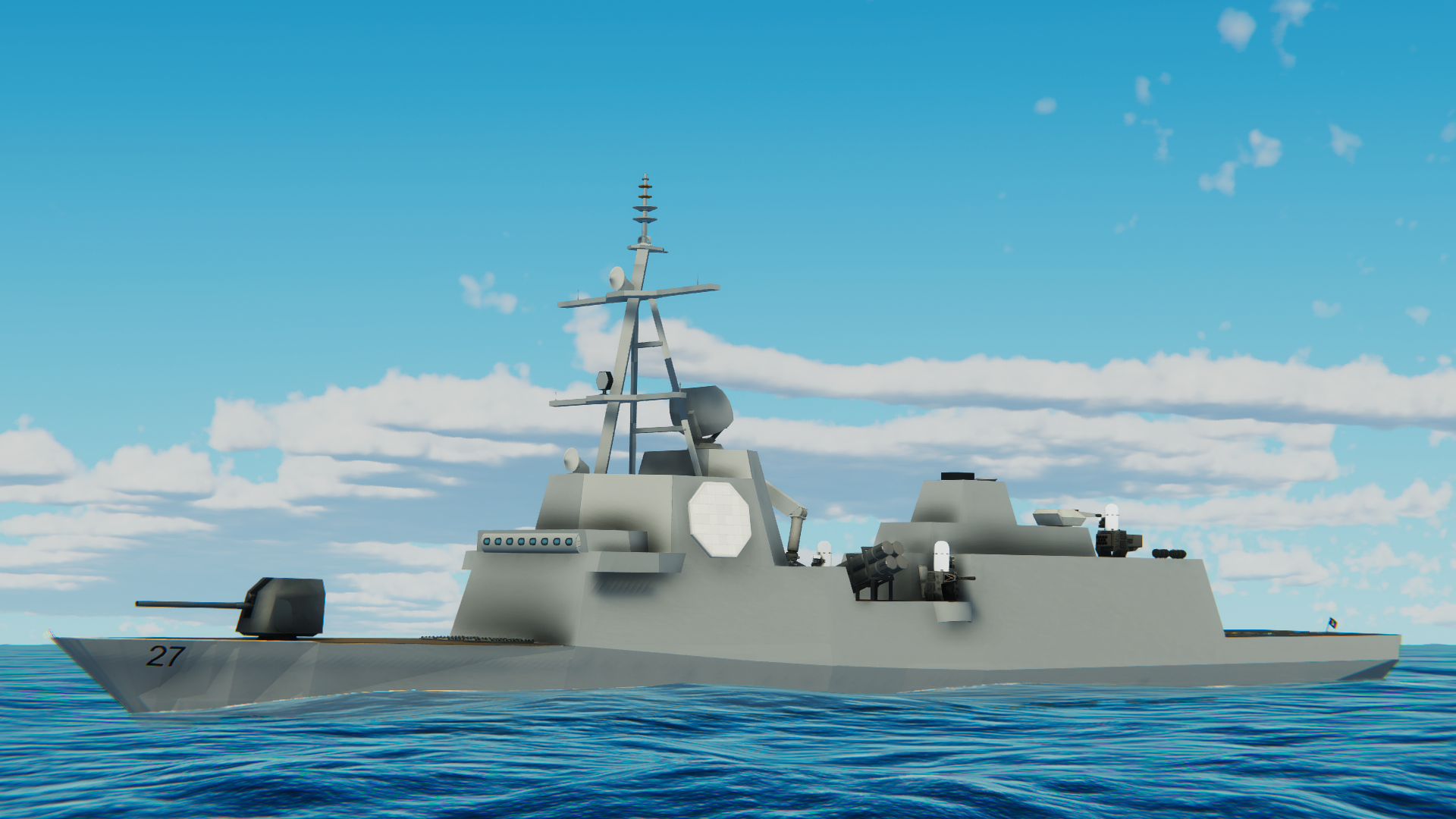 |
|||||
| FFCG-127 Robert B. Haverdam | |||||
| Role | Frigate Escort | ||||
| National Origin | Imperial Union | ||||
| Production History | |||||
| Designer | VAE Shipyards, Vocavium/Westray | ||||
| Number Built | 23, 20 on order | ||||
| Service History | |||||
| In Service | |||||
| 2188 - ongoing | |||||
| Used By | Zokesia Confederate Coast Guard Zokesian Royal Navy Imperial Union | ||||
| Vessel Characteristics | |||||
| Displacement | 1000 Tons | ||||
| Length | 96 m | ||||
| Beam | 13.8 m | ||||
| Height | 26 m | ||||
| Draft | 3 m | ||||
| Propulsion | x2 FROSTON Industries Electric Propulsion Motors x1 M1800 Gas Turbine Generator |
||||
| Max Speed | 29 kn (15 m/s) | ||||
| Operational Range | 1800 km | ||||
| Complement | 200 (24 officers, 176 enlisted) | ||||
| Sensors and Processing Systems | FROSTON CRYSTAL VAE SIMPSON radar VAE T-11 Sonar |
||||
| Armament | x1 57mm Naval Gun x2 Phalanx CIWS x1 SeaRAM Launcher x2 4-cell AshM Launcher 48 VLS cells |
||||
The Orion-Class Frigate is a class of guided-missile frigates currently in service in the Imperial Union and Zokesia, fulfilling its role as an affordable modern escort/patrol Frigate.
Development
The Orion-Class Frigate began development in 2185 under VAE system's subsidiary VSD to meet the IRN's new requirements for a next-generation escort/patrol frigate that could incorporate newly introduced technology at a lower cost than its traditional counterparts. In consideration of the newly deployed Huntsman-class Destroyer and the planned requirements of the Air Warfare Destroyer/Cruiser, the VSD's proposal revolved around the FROSTON Industries' new CRYSTAL (Combat Radar Yellow, Search and Track Array Luminator) system in order to provide basic-level fleet air protection at a low cost. Due to weak competition from other designers or lack thereof, the proposal was approved by the Imperial Navy Design Committee in 2186, and an initial order of 5 frigates was placed to be delivered by the end of the following year.
Design and Armament
As a next-generation surface combatant geared for escort and patrol duties, the Orion-class incorporated a wide range of new Imperial technology that pioneered their use on other vessels through out the Imperial Armed Forces. One noteworthy example is the inclusion of a reinforced keel for greater ASW effectiveness and survivability in case of a torpedo hit to the keel. While traditional keels would succumb to even indirect detonation, the newly introduced reinforcements will allow current and future Orion frigates to be combat-effective even after a direct torpedo hit.
Froston Industries' CRYSTAL system saw its first deployment on the Orions, with two arrays being mounted on the sides of the superstructure aft of the main bridge. While it does not provide full coverage of the combat area, the two arrays combined with secondary SIMPSON radar and illuminators enable long-range tracking of up to 16 enemy contacts, a marked increase from the preceding Acheron Class. Crew and technical data garnered from the radar systems onboard the lead ship HMS Orion during its initial combat trials allowed researchers at FROSTON Industries and VAE Shipyards to perfect system and software integration for their upcoming Future Air Warfare Destroyer/Cruiser project.
One of the most obvious changes made from VSD's initial proposal is the marked increase in maximum speed. While the original design was projected to reach a maximum speed of 20 knots using traditional diesel-electric propulsion, the IRN demanded the ship be capable of reaching 30 knots in order to keep up with Imperial Carrier fleets. To accommodate for this demand, VAE Shipyards replaced their traditional propulsion-power system with Froston Industries' Electric Propulsion Motor Mk3 and a M1800 Gas Turbine generator. Although slightly more costly than their traditional counterparts, it was discovered in HMS Orion's maiden voyage that the new systems were far more efficient and reliable in long-term operations, prompting the IRN to investigate the possibilities of refitting major combatants to utilise the new technology.
The frigate also boasts an impressive arsenal for its size with 48 VLS cells fore of the bridge, one 57mm naval gun, one SeaRAM launcher, two Phalanx CIWS systems and two 4 cell AshM launchers located amidships. In its standard escort configuration the VLS cells are designed to accommodate ESSM medium range interceptor missiles but they are also able to be outfitted with RIM-66 long-range interceptors or a limited range of cruise missiles to supplement the 8 AshMs stored in box launchers.
Another noteworthy feature of the Orion-class is the large mission bay located amidships. Despite the frigate's small size, the mission bay is able to accommodate up to two K-53B II VTOL Fighters or ASW Helicopters as well as two BIMO (Boat, Inflatable, Multi-service Operational) high-maneuverability boats, giving the Orion its characteristic mission flexibility.
Contract Award and Foreign Sales
In November 2186, VAE Shipyards was awarded with a 1.5M Kredit contract by the IRN to produce 5 frigates with an option for 15 additional frigates after the initial delivery. However, following the ship's stellar performance during its maiden voyage and combat trials that far exceeded application, the order was expanded to 5+20, all expected to be delivered by the end of 2201.
Both the Confederate Coast Guard and Navy expressed interest in the frigate even during its design phase at VSD. The frigate's cost-effectiveness combined with its large mission bay made it a strong contender for the two service's future combatant program, and by 2187, contracts for 10 frigates from the Coast Guard and 8 for the Navy were awarded to VAE Shipyards. All 18 frigates were delivered and are in active service under the two services.
Service History
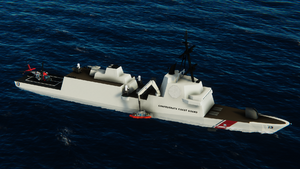
N/A
